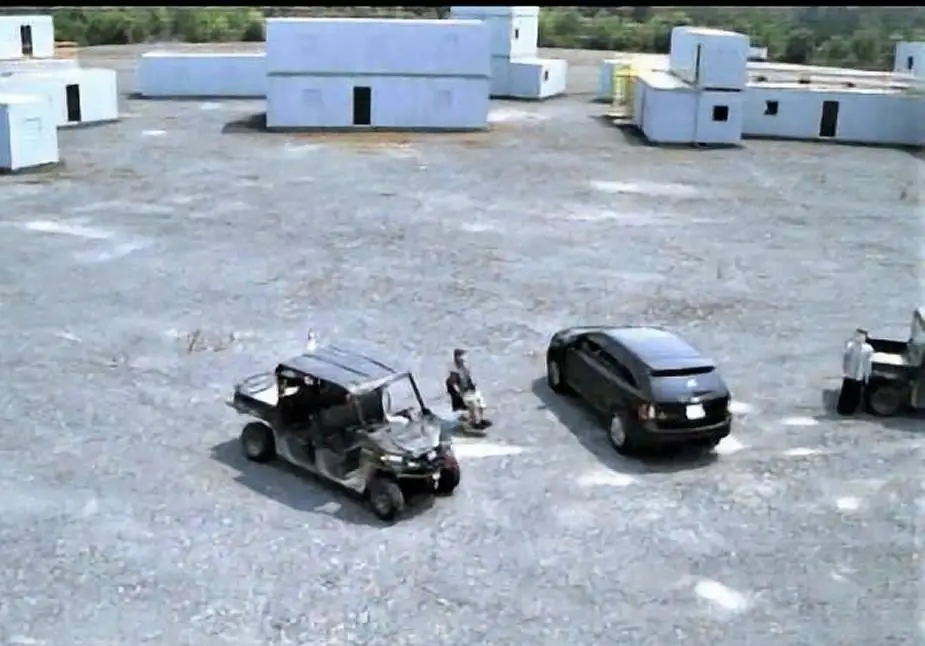New method of US Army accelerates AI decision-making
A new solution compresses and offloads critical data from battlefield machines more efficiently, enabling faster AI processing and decision-making on the battlefield. U.S. Army DEVCOM Army Research Laboratory Public Affairs explains.
Follow Army Recognition on Google News at this link

Using the original_frame.png, the encoder/decoder from the Deep Compressive Offloading approach was used to process the image and reconstruct it to produce a compressed version of the image. Notice that some information is not captured in the compressed image, e.g., the orange cone in the original frame does not appear to have the orange color in the compressed frame. The point though is that the information needed to maintain detection performance is preserved and other information is thrown out to reduce the image size. The compressed/reconstructed image is 48.5kB compared to the 2.5MB for the original, which is only 2% of the original size. (Picture source: U.S. Army).
Researchers from the U.S. Army Combat Capabilities Development Command, known as DEVCOM, Army Research Laboratory and university partners from the Internet of Battlefield Things Collaborative Research Alliance, or IoBT CRA, developed a new solution to provide battlefield applications with pressing machine intelligence, even when the local environment is not able to facilitate AI processing.
This new solution offloads data from the battlefield to remote processing engines by enabling a much higher degree of compression of the data than previously possible, researchers said: “The computational requirements of AI in the battlefield are burdensome for many low-capacity devices,” said Dr. Tarek Abdelzaher, a professor at the University of Illinois Urbana-Champaign and the academic lead of the lab’s IoBT CRA. “Offloading data from the field to a more computationally capable machine is a potential solution to facilitate more efficient processing.”
Transferring data between field devices like Army-relevant sensors, such as cameras, LiDARs, radars, IR sensors and a remote server can take significant amounts of time, Abdelzaher said. Compressing the data puts less burden on the battlefield system, allowing it to send the data to the processing machine elsewhere more efficiently — even across low-bandwidth, contested links.
This improved processing speed significantly reduces the delay between initial sensing and subsequent decision-making, enabling commanders to immediately act on data in an intelligent manner.
Researchers recently tested the compression solution by offloading an image from one device at the lab’s Multi-Purpose Sensing Area at White Sands Missile Range and an IoBT CRA server in Massachusetts. Testing of this solution showed that compression was four times more effective than an image’s compression capability, which is the current image compression standard, researchers said.
Researchers achieved this ultra-high compression capability by considering future use needs; only those data features that the AI will need to use later for accurate processing are preserved during compression. This enables the machine to achieve a much higher compression ratio than existing compression techniques that do not consider future use — all without a significant loss of accuracy.
“For example, in an application where the goal is to recognize different types of vehicles in an image, what cues are used by the AI to distinguish the different types of vehicles?” Abdelzaher asked. “Those cues should be preserved by compression when data is sent from the field. Other irrelevant information can be compressed away to improve compression abilities.”
This solution can revolutionize AI for Army applications and increase autonomy in mission execution by bringing AI virtually to the point of need in the field through faster offloading and remote processing.
“In a world where autonomy and machine intelligence play increasingly bigger roles in future conflicts, efficient solutions for moving complex sensor data to the right processing engines will become critical,” said Dr. Maggie Wigness, Army researcher and deputy collaborative alliance manager of the IoBT CRA. “Compressive offloading, and other sensing and processing research being conducted in the IoBT CRA, are essential to the Army in effectively preparing for the future battlefield.”


























